14 Flowering Vines That Keep Growing Into Fall
When the temperatures start to drop, many gardeners wonder if their plants will keep blooming. Fortunately, certain flowering vines can continue to grow well into fall, offering a second wave of color. These vines can climb trellises, fences, or spread across the ground, adding beauty to any garden. Fall provides the perfect backdrop for their late-season flowers.
This post may contain affiliate links, which helps keep this content free. Please read our disclosure for more info.
Clematis

Clematis is a versatile flowering vine known for its vibrant blooms that come in a variety of colors. While most varieties bloom in spring and early summer, some types, such as the Clematis ‘Taiga,’ produce stunning flowers well into the fall. This vine can be trained to grow along trellises, fences, or arbors, adding a touch of elegance to your garden. Clematis requires well-drained soil and a sunny location to thrive, making it a great addition to fall gardens.
In the cooler months, Clematis vines may slow their growth, but they continue to produce late-blooming flowers that can last into autumn. These vines also grow well in containers, offering flexibility in their placement. Pruning the vine properly after the blooming period ensures continued health and promotes better flowering the following year. Their long-lasting blooms make them a favorite for late-season garden displays.
Trumpet Vine (Campsis radicans)

The Trumpet Vine is a fast-growing, hardy plant known for its bold, trumpet-shaped flowers. These flowers are typically bright orange, attracting hummingbirds to your garden during the late summer and fall. Trumpet vines can quickly cover fences and trellises, making them ideal for creating privacy or adding vertical interest. They thrive in full sun and well-drained soil, making them perfect for areas with plenty of sunlight.
As fall approaches, the Trumpet Vine continues to bloom, producing flowers that last until the first frost. This vine is also drought-tolerant once established, which makes it a low-maintenance option for gardeners. It can be pruned back after blooming to maintain its shape, but avoid cutting too much during fall to allow the plant to continue producing flowers. The vibrant blooms paired with its vigorous growth make it a standout in any fall garden.
Morning Glory (Ipomoea)
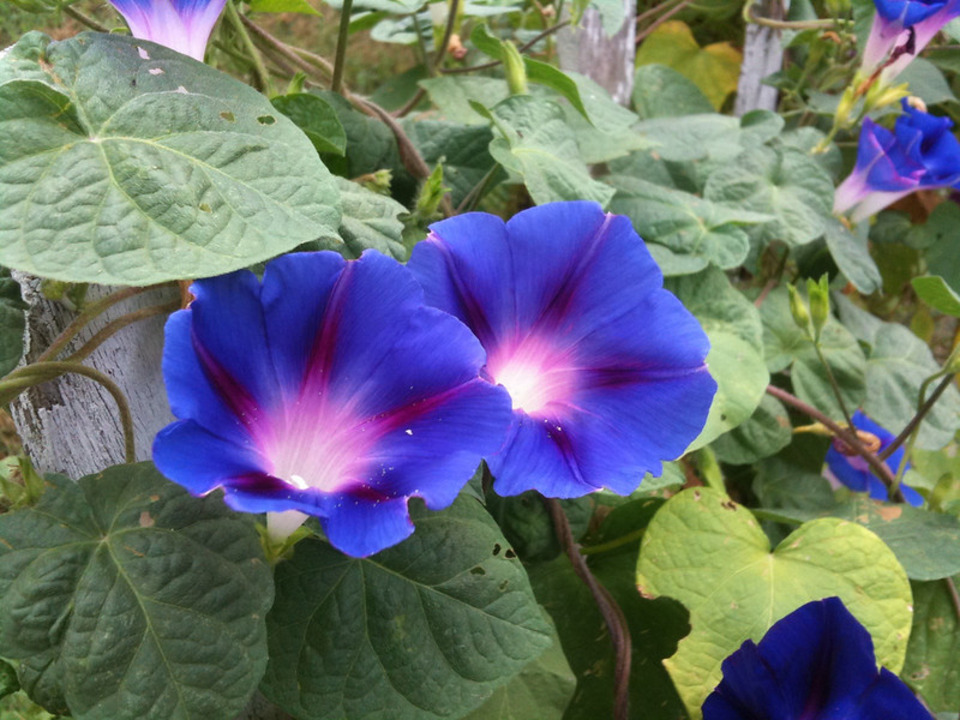
Morning Glory vines are known for their stunning, funnel-shaped flowers that open in the morning and close by the afternoon. They are available in various colors, including purple, pink, and blue, and bloom abundantly through late summer and fall. These vines thrive in sunny spots and need well-drained soil to grow well, making them ideal for sunny gardens. Morning Glories are particularly useful for covering fences and trellises quickly.
Though they are annuals in cooler climates, Morning Glories still provide a burst of color throughout the fall months before the first frost. They are incredibly easy to grow from seeds and typically bloom within a few weeks of planting. Deadheading spent flowers can encourage more blooms throughout the season. Their fast-growing nature and vibrant colors make them a perfect vine for adding instant beauty to any garden as the weather cools.
Wisteria

Wisteria is known for its cascading clusters of blue to purple flowers, typically seen in spring, but some varieties bloom again in late summer or early fall. This robust vine can quickly grow over large structures, creating an impressive display of hanging flowers. Wisteria vines thrive in full sun and well-drained soil, requiring a little extra space to spread out. With proper care, they can live for many years, growing stronger and more beautiful with age.
In the fall, certain Wisteria varieties, like the Japanese Wisteria, will produce a second round of flowers that continue to attract pollinators. Their long, graceful clusters of flowers offer beauty long after the summer blooms have faded. Wisteria also benefits from regular pruning after flowering to promote better growth the following year. The vine’s sturdy growth and stunning blooms make it a cherished choice for gardeners wanting to enjoy flowers into the cooler months.
Sweet Autumn Clematis (Clematis terniflora)
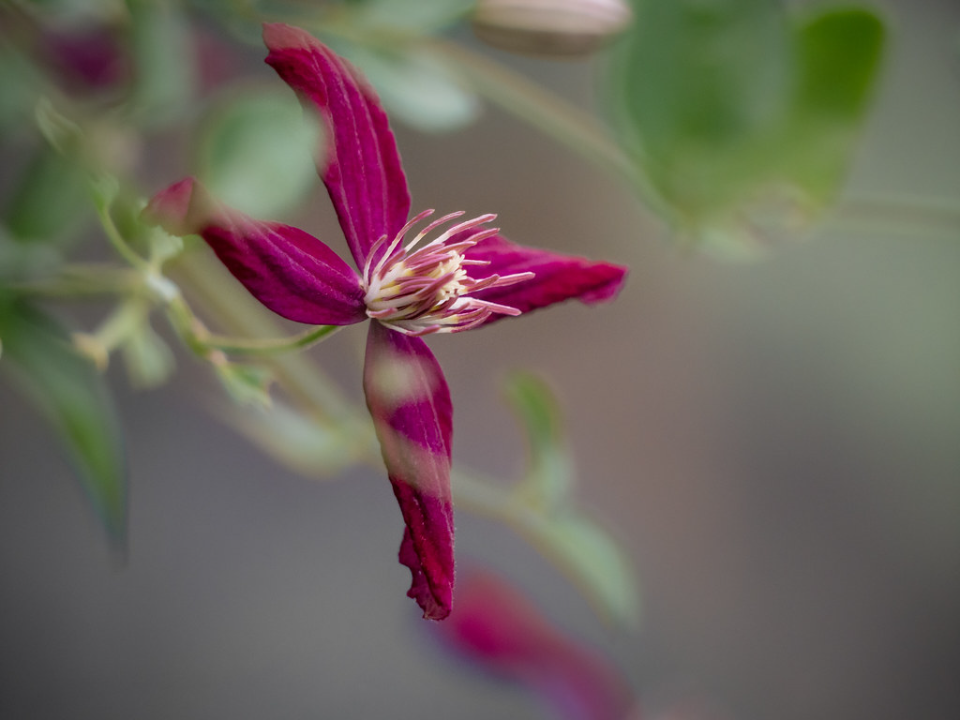
Sweet Autumn Clematis is a fall-blooming variety of Clematis that offers fragrant white flowers, ideal for late-season gardens. This hardy vine blooms from late summer into fall, producing small, star-shaped flowers that attract pollinators. Known for its vigorous growth, this Clematis can quickly cover fences, trellises, and even walls. It thrives in full sun to partial shade, making it adaptable to various garden settings.
Its sweet fragrance fills the air as the vine continues to bloom through the fall months. Sweet Autumn Clematis is also drought-tolerant and relatively low-maintenance once established. While it blooms on new wood, it can benefit from some light pruning after the flowers fade. This vine’s ability to bloom late into the season makes it a popular choice for gardeners who want to extend the flowering season.
Passionflower (Passiflora)
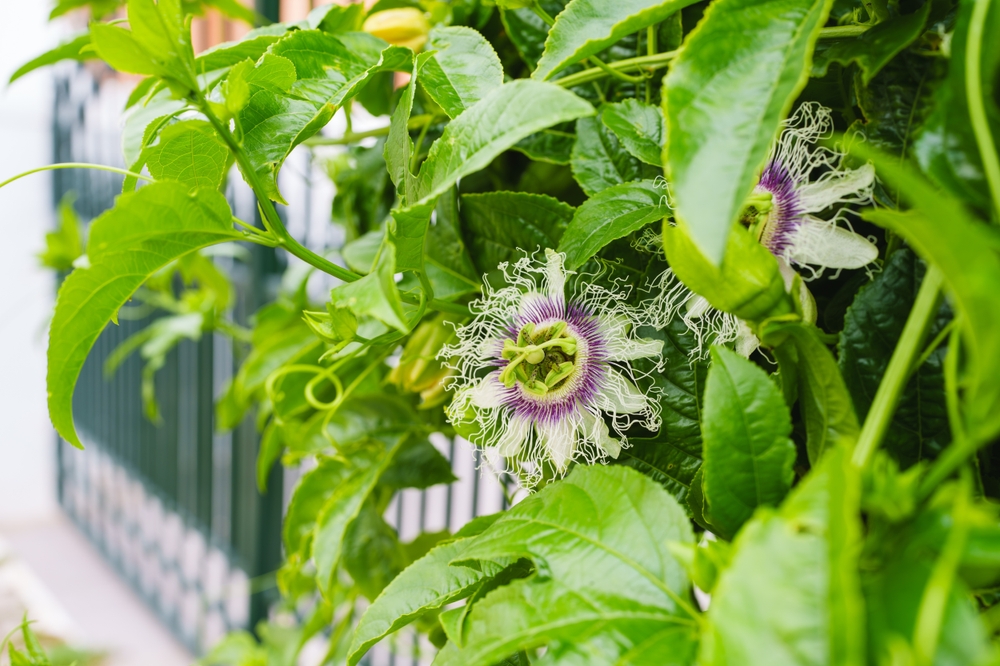
Passionflower is a unique and exotic vine that produces intricate, vibrant blooms that continue into the fall. The flowers come in a range of colors, from purple to white, and are known for their distinctive appearance. These vines thrive in full sun and well-drained soil, growing rapidly once established. The fruit of the Passionflower, also known as the “Passion Fruit,” may also begin to appear in the fall, adding to the vine’s appeal.
Passionflower vines can grow up to 15 feet or more, making them excellent for creating vertical interest in gardens. As the weather cools, the vines continue to bloom, providing striking color and attracting pollinators like bees and butterflies. Passionflower requires regular watering, especially during dry spells, but is generally hardy and easy to grow. Its combination of unique blooms and fruit makes it a standout option for late-season gardening.
Bougainvillea
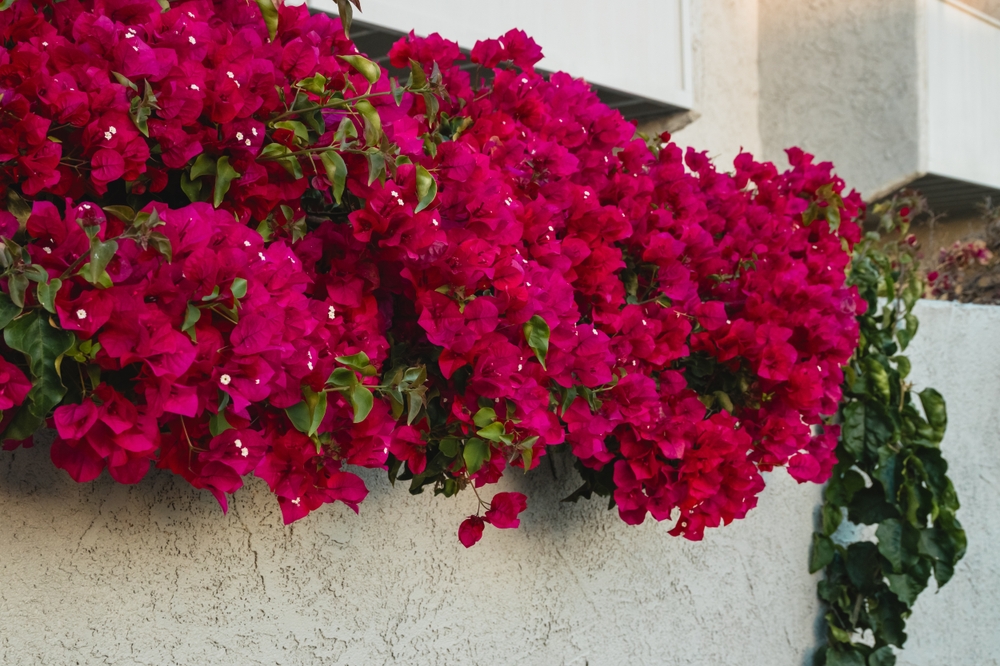
Bougainvillea is a tropical vine that produces vibrant, paper-like bracts in shades of pink, purple, and orange. Although it is most commonly associated with warm climates, it can thrive in colder regions when grown in containers or in protected areas. Bougainvillea requires full sun and well-drained soil to thrive, making it an ideal choice for areas with plenty of sunlight. Its ability to bloom profusely throughout the fall gives it lasting appeal in gardens.
During the fall months, Bougainvillea continues to display vibrant colors, brightening up even the dullest of spaces. These vines grow quickly and can be trained to climb fences, trellises, or walls, adding a tropical flair to your garden. Bougainvillea thrives with regular pruning, which helps maintain its shape and encourages more blooms. It is a great choice for gardeners who want a long-lasting, low-maintenance flowering vine.
Carolina Jessamine (Gelsemium sempervirens)
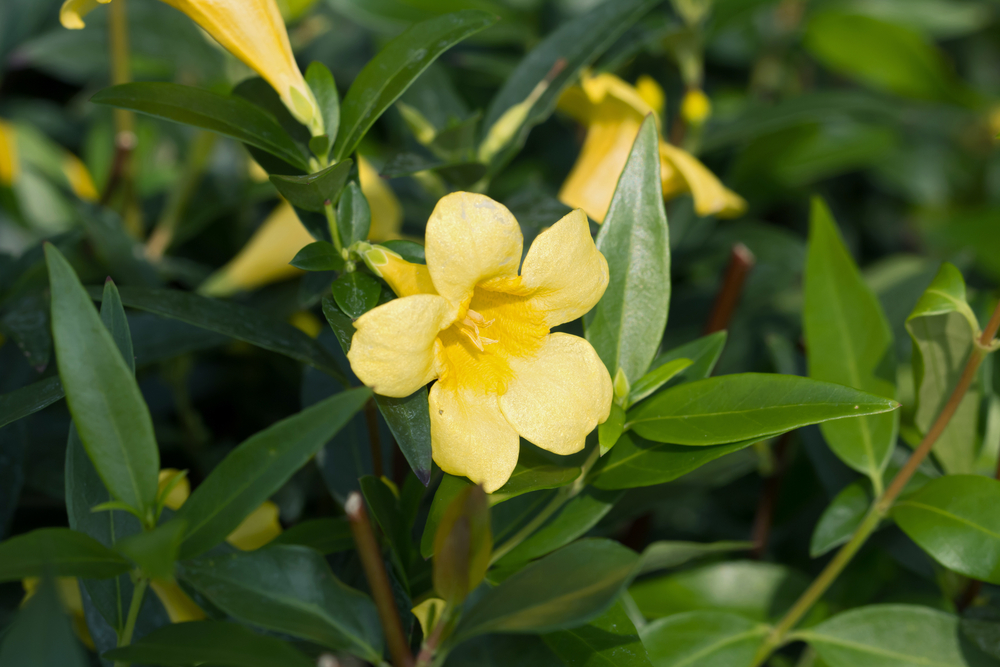
Carolina Jessamine is an evergreen vine known for its fragrant yellow flowers, which bloom in late winter and early spring. However, some varieties will bloom again in the fall, producing additional bright yellow blossoms. This vine is ideal for covering trellises, fences, and arbors, as it grows quickly and vigorously. It thrives in both sun and partial shade, making it versatile for many garden types.
Despite being a slow starter, once it takes off, Carolina Jessamine continues to grow and bloom well into the fall. Its sweet scent and bold yellow flowers make it a favorite among gardeners who enjoy fragrant plants. Carolina Jessamine also attracts pollinators like bees and butterflies, making it a valuable addition to any garden. With minimal care, this vine can last for many years, offering both beauty and fragrance long after summer.
Honeysuckle (Lonicera)

Honeysuckle is a classic flowering vine known for its sweet fragrance and attractive tubular flowers. It can bloom in a variety of colors, from white and yellow to pink and red, and will continue to flower well into the fall months. Honeysuckle thrives in full sun to partial shade and prefers well-drained soil, making it a versatile choice for many garden types. Its fast-growing nature allows it to quickly cover trellises and fences, adding beauty and privacy to your space.
Throughout fall, Honeysuckle’s fragrant flowers continue to attract pollinators like bees and hummingbirds. Regular pruning after flowering ensures that the vine stays healthy and continues to produce abundant blooms. The variety of colors and the sweet scent make Honeysuckle a cherished vine for gardeners who want to extend the blooming season. Its resilience and long-lasting blooms make it a great option for year-round interest.
Confederate Jasmine (Trachelospermum jasminoides)
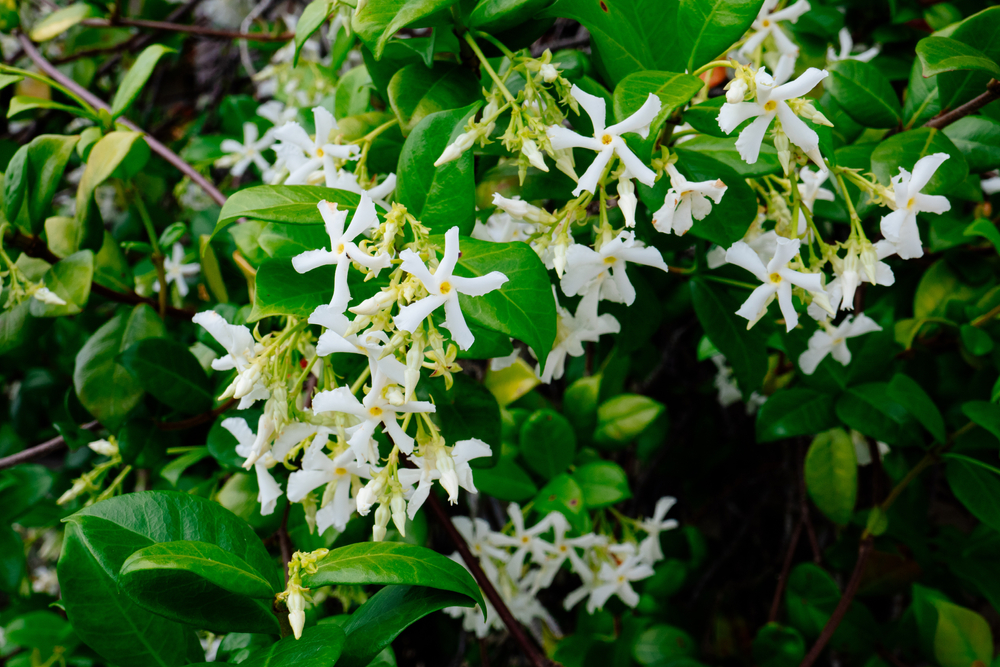
Confederate Jasmine, also known as Star Jasmine, is a fragrant vine that blooms in clusters of white, star-shaped flowers. While it is most often associated with spring, certain varieties will bloom again in late summer or fall. This evergreen vine can grow up to 20 feet, making it perfect for covering fences, walls, or pergolas. It thrives in full sun to partial shade, ensuring it fits well into various garden environments.
As the weather cools, Confederate Jasmine continues to provide its sweet, jasmine-like fragrance. The vine is hardy and drought-tolerant once established, requiring minimal maintenance. Confederate Jasmine is also relatively pest-free, making it a low-maintenance addition to your garden. Its ability to bloom well into fall and its delightful fragrance make it a beloved choice for many gardeners.
Black-Eyed Susan Vine (Thunbergia alata)

Black-Eyed Susan Vine is a charming, fast-growing vine that produces striking orange or yellow flowers with dark centers. The blooms resemble the familiar Black-Eyed Susan flowers but grow on a more compact vine, making them suitable for containers and smaller spaces. This vine thrives in full sun and well-drained soil, where it will bloom from early summer into the fall. It is a great option for brightening up porches, fences, or trellises.
As fall approaches, the Black-Eyed Susan Vine continues to produce a profusion of flowers, making it an excellent choice for a late-season display. The vine is easy to grow from seed and can be trained to climb or spill over containers. Regular deadheading helps extend the bloom period, ensuring that the plant stays vibrant throughout the season. Its cheerful flowers are perfect for adding color and charm to any garden.
Climbing Roses
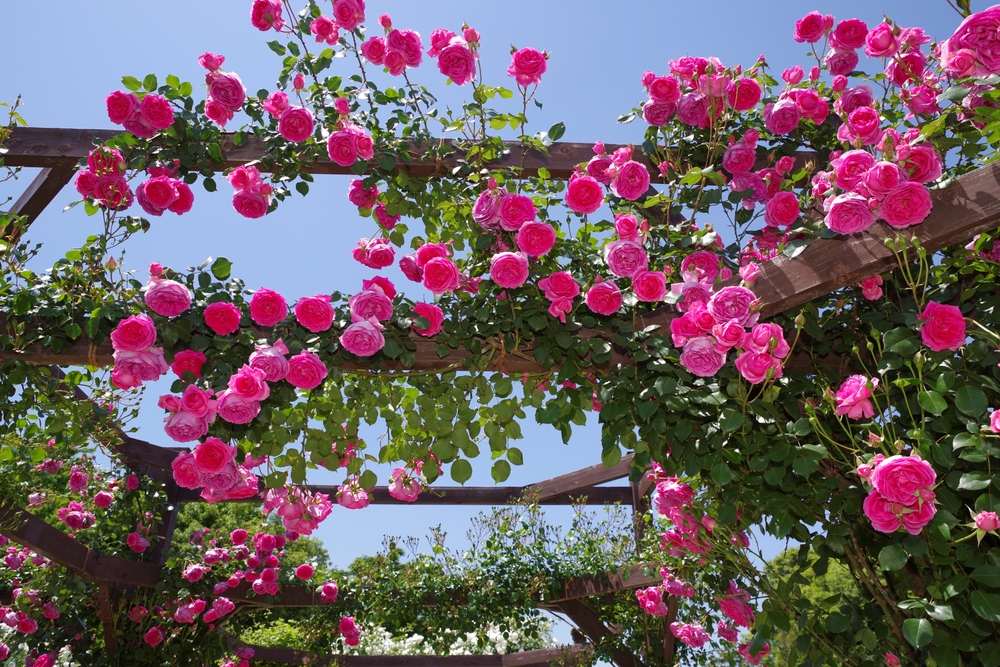
Climbing Roses are known for their elegant, fragrant blooms that add a touch of romance to any garden. Many varieties, such as the ‘New Dawn’ rose, continue to produce beautiful flowers well into fall. These vines can be trained to grow up trellises, fences, or arches, creating a stunning display of color. Climbing Roses require full sun and regular pruning to keep them healthy and encourage more blooms.
Throughout the fall, Climbing Roses produce colorful blooms, with some varieties even continuing to flower into early winter. These vines often attract bees and butterflies, making them an excellent addition to pollinator-friendly gardens. With their ability to thrive into the cooler months, Climbing Roses offer lasting beauty. Proper care, such as deadheading and protecting them from harsh weather, ensures they continue to perform well in fall.
Virginia Creeper (Parthenocissus quinquefolia)

Virginia Creeper is a fast-growing vine that is often admired for its vibrant red and purple foliage in the fall. While it is primarily known for its colorful leaves, it also produces small greenish-white flowers in late summer. This vine can quickly cover large areas, making it ideal for covering fences, walls, or trellises. It thrives in both sun and shade, offering flexibility in garden design.
As the weather cools, the Virginia Creeper’s leaves transition to brilliant reds and purples, providing a stunning visual display. The small flowers attract pollinators, though the vine is most famous for its colorful foliage. Virginia Creeper is low-maintenance, requiring minimal pruning and care once established. Its ability to thrive in a variety of conditions and its dramatic fall color make it a perfect choice for late-season gardens.
Coral Honeysuckle (Lonicera sempervirens)

Coral Honeysuckle is a vibrant, native flowering vine that produces tubular flowers in shades of red, orange, and yellow. These flowers continue to bloom into the fall, attracting hummingbirds and other pollinators. Coral Honeysuckle thrives in full sun and well-drained soil, making it a great addition to sunny garden spaces. It is also known for its ability to tolerate a variety of soil types and conditions.
As the season progresses, Coral Honeysuckle’s colorful blooms provide a bright pop of color in the garden. The vine is relatively low-maintenance, needing only occasional pruning to keep it in shape. Its continued blooming throughout fall makes it a valuable addition for extending the growing season. The vine’s ability to thrive in a range of conditions and its ability to attract pollinators make it a top choice for many gardeners.
This article originally appeared on Avocadu.
